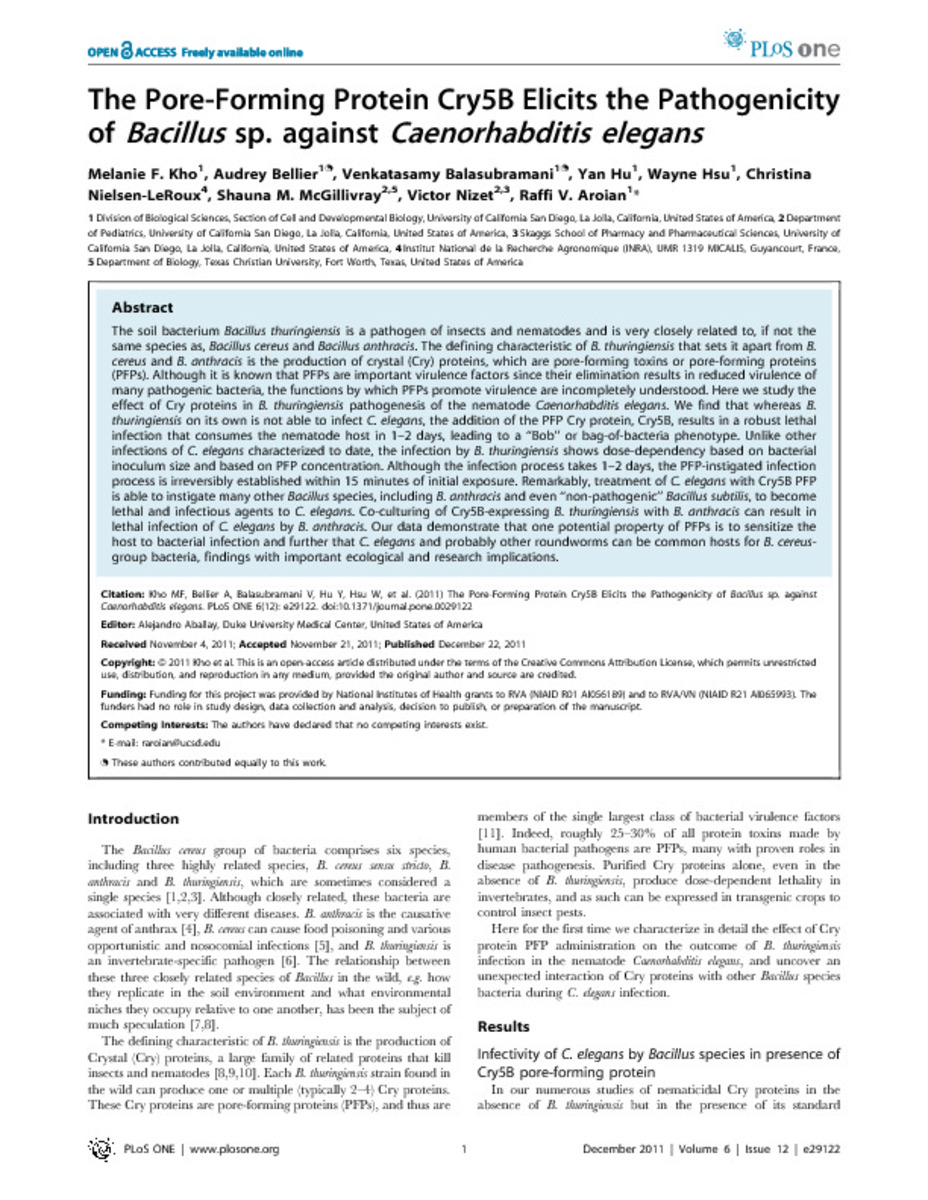The Pore-Forming Protein Cry5B Elicits the Pathogenicity of Bacillus sp. against Caenorhabditis elegansShow full item record
| Title | The Pore-Forming Protein Cry5B Elicits the Pathogenicity of Bacillus sp. against Caenorhabditis elegans |
|---|---|
| Author | Kho, Melanie F.; Bellier, Audrey; Balasubramani, Venkatasamy; Hu, Yan; Hsu, Wayne; Nielsen-LeRoux, Christina; McGillivray, Shauna M.; Nizet, Victor; Aroian, Raffi V. |
| Date | 2011-12-22 |
| Abstract | The soil bacterium Bacillus thuringiensis is a pathogen of insects and nematodes and is very closely related to, if not the same species as, Bacillus cereus and Bacillus anthracis. The defining characteristic of B. thuringiensis that sets it apart from B. cereus and B. anthracis is the production of crystal (Cry) proteins, which are pore-forming toxins or pore-forming proteins (PFPs). Although it is known that PFPs are important virulence factors since their elimination results in reduced virulence of many pathogenic bacteria, the functions by which PFPs promote virulence are incompletely understood. Here we study the effect of Cry proteins in B. thuringiensis pathogenesis of the nematode Caenorhabditis elegans. We find that whereas B. thuringiensis on its own is not able to infect C. elegans, the addition of the PFP Cry protein, Cry5B, results in a robust lethal infection that consumes the nematode host in 1-2 days, leading to a "Bob" or bag-of-bacteria phenotype. Unlike other infections of C. elegans characterized to date, the infection by B. thuringiensis shows dose-dependency based on bacterial inoculum size and based on PFP concentration. Although the infection process takes 1-2 days, the PFP-instigated infection process is irreversibly established within 15 minutes of initial exposure. Remarkably, treatment of C. elegans with Cry5B PFP is able to instigate many other Bacillus species, including B. anthracis and even "non-pathogenic" Bacillus subtilis, to become lethal and infectious agents to C. elegans. Co-culturing of Cry5B-expressing B. thuringiensis with B. anthracis can result in lethal infection of C. elegans by B. anthracis. Our data demonstrate that one potential property of PFPs is to sensitize the host to bacterial infection and further that C. elegans and probably other roundworms can be common hosts for B. cereus-group bacteria, findings with important ecological and research implications. |
| Link | https://doi.org/10.1371/journal.pone.0029122
https://repository.tcu.edu/handle/116099117/11240 https://journals.plos.org/plosone/article?id=10.1371/journal.pone.0029122 |
| Department | Biology |
| Subject | Bacillus thuringiensis
Nematode infections Caenorhabditis elegans Bacillus anthracis Bacillus subtilis Bacterial pathogens Bacillus cereus Bacterial lethality |
Files in this item
This item appears in the following Collection(s)
- Research Publications [1008]
Related items
Showing a few items related by title, author, creator and subject.
-
A novel role for tellurium resistance genes in the pathogenesis of Bacillus anthracis
Franks, Sarah Elizabeth (2013)Bacillus anthracis must avoid an array of antibacterial defenses by the host during infection. Although anthrax toxin and capsule, located on extra-chromosomal plasmids, play important roles in the pathogenesis of this ... -
Investigation of the ClpXP protease's connection to Bacillus anthracis cell wall characteristics
Evans, Christopher Ryan (2013)We recently demonstrated that ClpX is critical for the pathogenesis and resistance to cell wall-acting antimicrobials of Bacillus anthracis, the causative agent of anthrax. ClpXP is an intracellular protease conserved ... -
The Role Of ClpX In Bacillus Anthracis Cell Charge
Rosati, Renee M. (2012)Anthrax is a deadly disease caused by the gram-positive bacterium Bacillus anthracis. In order to be fully virulent, the bacteria must exhibit lethal factor toxin, edema toxin, protective antigen, and a capsule. We have ...
© TCU Library 2015 | Contact Special Collections |
HTML Sitemap






